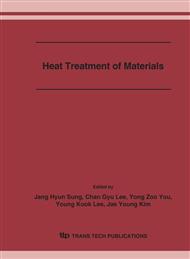p.579
p.585
p.591
p.597
p.603
p.609
p.615
p.623
p.635
Study On Nano-Structured SnO2-23wt%TiO2-21wt%RuO2 Coated Titanium Anode
Abstract:
Sn is one of the most important elements for the Cl2-evolving anode coatings, but it always used as a minor additive. In this paper, an Sn-based ternary oxide coating with its composition of SnO2-23wt%TiO2-21wt%RuO2 was prepared by a sol-gel technique through etching, painting, sintering and annealing. The differential thermal analysis (DTA) shows that the crystallization behavior of the ternary xerogel is more similar to that of pure xerogels SnO2. X-rays diffraction (XRD) indicates that the coating is composed of rutile phase (Sn,Ti,Ru)O2. Any other undesired phases, for example, anatase TiO2 and metallic ruthenium phases are not found in the coatings. The microstructure and the morphologies were studied by a transmission electron microscope (TEM) and a scanning electron microscope (SEM). The results of energy dispersive spectrometer (EDS) indicate Sn content in the coatings remain at high level and coincident with the nominal composition. The grain sizes in the coatings are around 4 nm. The voltage of Cl2-evolution and O2-evolution shows the ternary coating has good electrochemical properties.
Info:
Periodical:
Pages:
603-608
Citation:
Online since:
December 2006
Authors:
Keywords:
Price:
Сopyright:
© 2006 Trans Tech Publications Ltd. All Rights Reserved
Share:
Citation:


